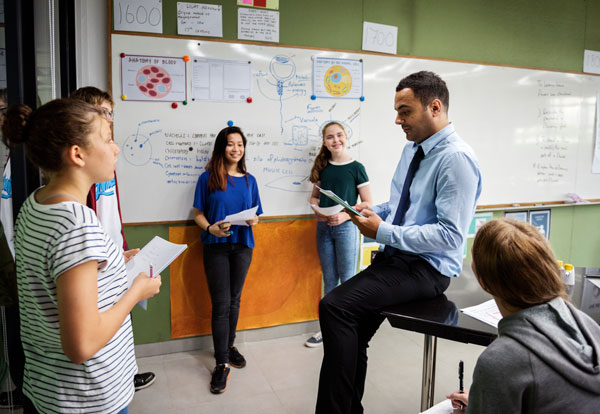Ample education research shows the impact of student engagement in academic success. Teachers play a vital role in creating a learning environment that motivates students to learn and cultivates engagement. This post takes a closer look at the relationship between student engagement and motivation and suggests strategies and activities educators can use to keep students engaged and motivated.
The Importance of Engagement and Motivation
Engagement and motivation are distinct yet related. Teacher, columnist, education center director, and author Nina Parrish defines motivation as the driving force that causes a student to take action, while engagement is the observable behavior or evidence of that motivation. Student motivation is necessary for engagement to occur, and engagement helps students feel more motivated (and more likely to continue engaging) into the future.
Student engagement remains a pressing concern and trending topic in education, with one Gallup study finding that students become less engaged, involved, enthusiastic, or committed as they age. While 74 percent of the study’s fifth-graders reported high levels of engagement with school, that figure dropped to roughly 50 percent by middle school and fell to about one-third by high school.
Motivating students is one of the major challenges teachers can face daily. Two main types of motivation drive students in the classroom. Intrinsic motivation, or internal motivation, is a personal passion and desire to learn that comes from within oneself. Students with a passion for reading, for example, will likely be more motivated to engage with learning grammar rules or new vocabulary words to help them explore more (and/or more challenging) books.
Extrinsic motivation, alternatively, comes from exterior influences such as rewards or punishments. Some extrinsic motivation—such as a class-wide, progress-tracking reward system, for example—can be beneficial in motivating students to engage in their learning and reach performance goals. However, if their extrinsic motivation is just to avoid punishment or disappointment, students may feel discouraged or afraid to even make an effort to engage for fear of failure. Identifying what motivates your students and understanding how motivation influences student engagement can help you personalize approaches for encouraging engagement in the classroom.
Tips to Motivate and Engage Students
- Create a sense of autonomy. Parish writes that self-regulated learning strategies can help increase students’ motivation and willingness to engage because they create a feeling of autonomy by offering choices that provide a sense of initiative, ownership, and control over their learning. In addition to working collaboratively, giving students opportunities to work autonomously develops their sense of competence and can result in increased intrinsic motivation and elevated performance. Teaching self-regulation skills lowers dependency on teacher intervention and helps students develop self-efficacy. If students can make choices in their learning, they’ll be inclined to become more self-disciplined, responsible, confident, and engaged.
- Be generous with praise. In several educational studies focusing on classrooms teaching English as a foreign language, researchers concluded that positive communication behaviors, including praise from a teacher toward their efforts or successes, result in feelings of happiness and pleasure. A sense of enjoyment is of high importance for motivating and engaging students. Those feelings leave learners much more motivated to actively take part in classroom activities and the learning process.
- Stay positive. Without even trying any specific strategies or classroom management tactics, your personality and individual teaching style can play a vital role in students’ motivation and engagement. Research has found that a teacher’s enjoyment of and confidence in their teaching positively impacts student engagement and motivation. Teachers with high confidence and self-efficacy in their teaching are more likely to have positive, proactive, and solution-focused relationships with their students—leaving learners more motivated to engage.
- Practice SEL. Social learning experiences and classmate interactions can boost students’ motivation to learn and allow them to apply what they’ve learned to new settings outside the classroom.
- Raise the bar. Activities and assignments that are too easy aren’t as effective at engaging students as ones that challenge them to reflect on and evaluate subjects in a new way or make connections between new ideas.
- Provide targeted and timely feedback. Giving prompt, constructive, and actionable feedback helps form positive relationships, shows students you care, and motivates them to keep working toward their goals.
- Consider student preferences when decorating. Ensure your classroom environment is warm, welcoming, and accepting of students from all cultures, backgrounds, and ability levels.
- Be open to trying new things. Keep up with new trends and findings in educational research, and seek out proven strategies and teaching techniques.
Discover More Strategies to Motivate Students and Creative Ways to Engage Students with Avanti
Through brief, on-demand instructional videos and accompanying downloadable resources, Avanti members have access to hundreds of proven and field-tested strategies for building relationships, motivating, and engaging students of all grade levels. Get started with a seven-day free trial to begin expanding your teacher’s toolkit today.

